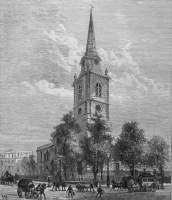 St Botolph Aldgate.
St Botolph Aldgate.
An 18th Century City church by George Dance the Elder, with significant pre-Fire monuments.
The church of St Botolph Aldgate, not to be confused with St Botolph Aldersgate, is of ancient provenance, with an earlier church on the site before the Normans, as the Chapel of a military order of clerics, the Knights of Knighten Guild. The current, 18th Century Church stands today on a small island site with a ribbon of churchyard around it, surrounded by roads, giving the disadvantage of loss of ambience, but the decided advantage that we can see it from all sides. It is built of dark or darkened brick, with stone edgings and around the widows etc, and also the spire rising above the square brick tower. Approaching from the City along Aldgate High Street, we see first the side, looking quite tall and bulky, with the principal window of three panels or lights, the centremost being a round arch, separated by thin columns from those on either side, which are squared off. This curious arrangement, repeated on the other side and on the rear of the church, is termed a Venetian window. From the front, which faces onto Aldgate High Street and thus southwards, we have a very different feel to the edifice, which seems all tower, in several stages above the curiously small door, with a round window beneath a blank pediment, then a semicircular window, another round one, then in the upper segment a round-arched window, somewhat larger than the entrance door, then the steeple, which commences with an octagonal blind storey acting as a clock tower, and surrounded with four pots, which seem somehow less prominent and noticeable form the side. From this end view, the aisles seem not particularly high, not particularly broad, and we notice the two shallow domes at their ends more than the roofs behind. The architect was George Dance the Elder, who also designed other London churches, and it was put up in the 1740s.
 Front view, emphasising domes.
Front view, emphasising domes.
Inside, it feels broader, a light, white painted church with galleries above the aisles, the rectangular central ceiling looking quite high, those over the aisles being not at an angle as from the outside, but curved and bearing a series of statues of angels in plaster. These are in pairs, and are youthful male figures between the ribs of the arched ceiling, with shields, scrolls, festoons, oak leaves and other light decorations. Panels with further decoration ornament the ceiling of the nave. All of this late Victorian work is due to the architect J. F. Bentley. Because of the aisles, we are not so conscious of the side windows, but the large Venetian window on the West end, filed with dark, jewel-like stained glass and above the altar, is a feature of the church.
The monuments are not numerous, but include two important pre-Fire ones and a notable bust:
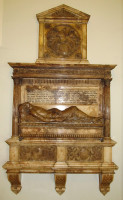
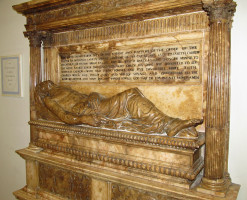 Monument to Thomas Lord Darcy and Sir Nicholas Carew, 1560ish.
Monument to Thomas Lord Darcy and Sir Nicholas Carew, 1560ish.
The monument to Thomas Lord Darcy and Sir Nicholas Carew, from the previous church on the site, has a full length statue of a reclining corpse in brown and cream marble, head thrown dramatically back to emphasise the thin throat, with bare torso and arm, and drapes wrapped around the hips and legs, leaving a foot exposed. The body lies on a raised bier, and the whole ensemble is flanked by fluted Corinthian columns, with two high relief panels below with ribbons and blank shields, and above, a large roundel in a frame with shield and knight’s helm, and a pediment.
The inscription on the tomb reads: Here Lieth Thomas Lorde Darcy of the Northe and sumtyme of the Order of the Garter, Sir Nicholas Carrew Knight sumtyme of the Garder, and Lady Elizabeth Carrew, daughter to Sir Thomas Brian Knight, and Sir Arthur Darcy Knight Yonger sone to the above named Lorde Darcy, and Lady Mary Darcy his dere wif, daughter to Sir Nicholas Carrew, who had tenne sonnes and five daughters. Here lieth Charles Will[ia]m and Phillip, Mary and Ursully, Sonnes and daughters to the saide Sir Arthur and Mary his wif whose sowlls God take to his infinit mercy, Amen.
Lord Darcy was executed in 1537, and Nicholas Carew in 1539, and according to the Royal Commission on Historic Monuments, the monument probably dates from about 1560.
Also from the previous church is our second important monument, to Robert Dow, d.1612, Citizen and Merchant Tailor of London, and Master of that Company: the inscription records that the monument was put up by the Company, and repaired by them in 1675. The monument consists of a painted half figure in a recess, with pilasters and a rounded pediment and shield above, and beneath the inscription, a further coat of arms on a short apron. The characterful portrait figure is symmetrically posed, staring at or above the viewer, wearing a cap, gown with bulky shoulders and white-painted broad collar, ruffs at neck and wrists. He has a moustache and forked beard, and rests his hands on a skull. The surround, unpainted, is in pinkish brown alabaster. Rather a grand thing. The sculptor is known to be a certain Christopher Kingsfield (d.1648), and the monument was paid for in 1622-23.
Our third monument is a bust of Sir John Cass, d.1718, founder of the School of that name just down the road, and Master of both the Carpenters’ Company and the Skinners’ Company, MP etc. In full wig with a broad treatment of the locks of hair.
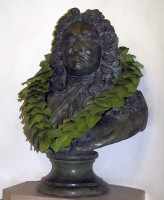 Bust of Sir John Cass, d.1718.
Bust of Sir John Cass, d.1718.
There are also several panel monuments, a few being from the previous church:
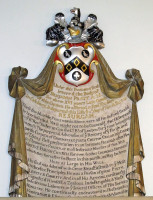
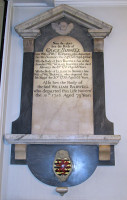 Early 18th Century: monuments to Benjamin Pratt and Grace Barwell.
Early 18th Century: monuments to Benjamin Pratt and Grace Barwell.
Among the earlier monuments, I did not see that to Captain Robert Silk, d.1701/2, and wife Martha, d.1689, with cherubic head and a vase. The church apparently also contains, in the vestry, the celebrated, mummified head of Henry Grey, Duke of Suffolk, executed in 1554. He was the father of Jane Grey, and this head was brought to the Church from the long-gone Church ofthe Holy Trinity in Minories.
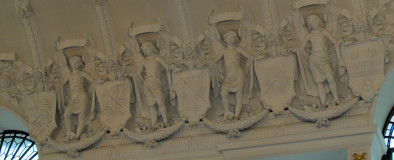 Male angels on the ceiling, J. F. Bentley architect.
Male angels on the ceiling, J. F. Bentley architect.
Among other furnishings, we should mention a modern bronze statue of a standing female, holding a crown of thorns. Also the Harris Organ, with a painted cartouche noting it was the gift of Thomas Whiting to the ‘hole Parrish’ in 1676, and sporting two pairs of reclining cherubs, and likewise two pairs of cherubic heads, painted wood. And an iron thing with shields and a crown on top, perhaps a sword rest or for processional use.
So much for the church interior. Outside, a few ruinous tombstones are close against the wall of the church, none of sculptural interest, dating it seems from 1820s-1840s so far as I could decipher them. More interestingly, against the railing is a substantial drinking fountain, the water once but no longer issuing from a shell forming the backing to the basin. We see the usual pink shap granite, pale stone, and decayed terra cotta bricks. An inscription notes that the fountain is in memory of Frederic David Mocatta, d.1905; the fountain itself is dated to the following year.
Just along the road is the John Cass School, a grand Queen Anneish block, with some minor sculptural ornament to the pillar tops, and winged cherub heads and festoons. There are two niches, with charity children, male and female, rather squat, painted things wearing uniform, and presumably from the 18th Century.
With many thanks to the Church for giving permission to include photos from inside; their website is at www.stbotolphs.org.uk
West to St Katharine Cree // Other City Churches // London sculpture // Sculptors // Introduction to church monuments
George Dance the Elder // St Leonard Shoreditch
Angel statues // Cherub sculpture
Visits to this page from 10 Jan 2013: 11,009